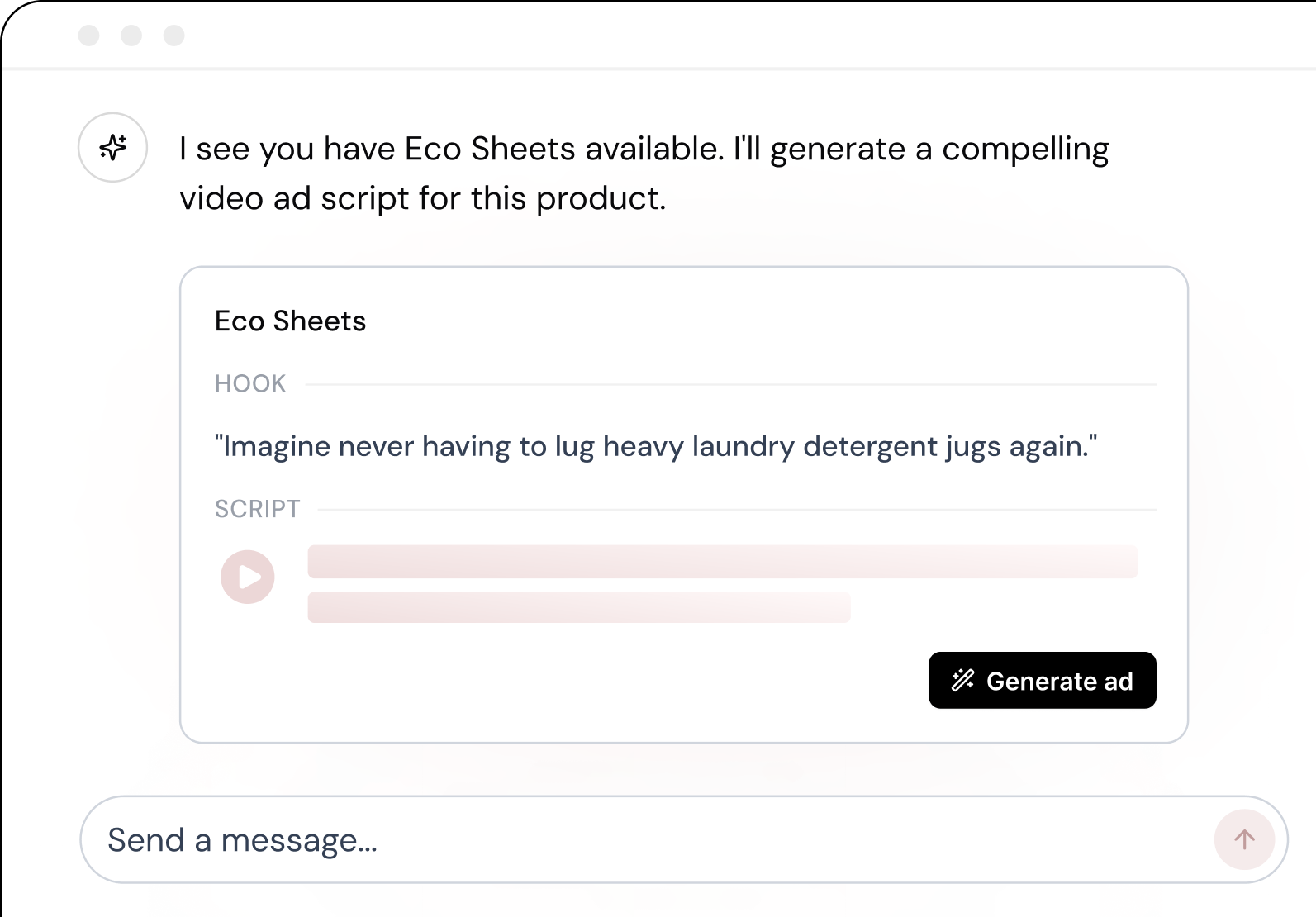A well-written commercial script tells a story that resonates, going beyond just selling a product. Whether introducing a new product or strengthening a brand’s presence, the right words can shape perception, spark an emotional response, and drive action.
The key is to balance clarity with creativity (and AI-powered creativity counts too).
A strong script is purposeful and concise, delivering a message that’s easy to understand and hard to ignore. It avoids fluff, speaks directly to the audience, and leaves room for the visuals and performance to shine.
You need to take a strategic, thoughtful approach to writing commercial scripts—one that prioritizes connection, impact, and long-term value.
Commercial Scripts 101
Before you start writing, it helps to zoom out and understand what a commercial script really is—and what it isn’t.
At its core, it’s a blueprint. One that outlines what’s said, what’s seen, and how everything flows together. It gives your creative team clarity, keeps messaging consistent, and sets the tone for a polished, purposeful production.
How Commercial Scripts Differ from Other Formats
Unlike film or long-form content, commercial scripts are built for speed and focus. Most run between 15 and 60 seconds and are designed to deliver one clear message.
In that short window, you need to spark interest, communicate value, and invite action—without overwhelming the viewer.
Word Count and Structure Guidelines
The format can shift slightly depending on where your ad will live. A 30-second TV spot might land around 60–75 words, while a 15-second social ad may need to stay closer to 30–40.
But no matter the length, the structure stays consistent: lead with a hook, get to the core message, then close with confidence.
When done right, a script becomes the foundation for storytelling that converts.
Preparing to Write Your Commercial Script
Writing a great commercial script starts long before the first line of dialogue. Like any strong campaign asset, it needs to be rooted in strategy—anchored by clear goals, a deep understanding of your audience, and a message that moves people to act.
Start with Strategy, Not a Blank Page
Before drafting your script, take a step back and define the bigger picture.
What’s the core goal of this commercial? Are you spotlighting a new product, launching a limited-time offer, or simply introducing your brand to a wider audience?
Anchoring your message in a clear objective keeps your creative process focused—and impactful.
Know Who You're Talking To
A compelling script starts with a deep understanding of the people you’re trying to reach.
What matters to them? What problems are they trying to solve—and how can you help?
The more specific you are about your audience’s mindset, the more meaningful your message becomes. If you need support here, tools like audience insights or brand persona workshops can help bring those profiles into sharper focus.
Refine the Message and Call to Action
Once your objective and audience are clear, you’re ready to shape the message.
What’s the one takeaway you want viewers to remember? And just as important—what action do you want them to take?
Whether it’s clicking through to learn more, signing up for a service, or making a purchase, your call to action should feel natural, relevant, and easy to follow.
Formatting Your Commercial Script
Once your strategy is in place, it’s time to bring it to life on the page. A well-formatted script isn’t just a nice-to-have—it’s essential for smooth collaboration between creative, production, and client teams.
When everyone can quickly see how audio and visuals align, production moves faster and more efficiently.
Use a Two-Column Layout for Alignment
Most commercial scripts follow a standard two-column format: audio on the left, visuals on the right.
This structure ensures that voiceovers, sound effects, and music cues line up clearly with corresponding shots, movements, and on-screen elements—creating a shared vision across departments.
Keep the Top of the Script Organized
Start with a header that includes all the key details: the project name, client, script version, and date. It’s a small step, but it goes a long way in keeping feedback loops streamlined and minimizing version confusion as you move from concept to production.
Follow Formatting Conventions for Clarity
Following basic script formatting conventions will help you organize everything and make collaboration easier.
- Sound effects (SFX), music cues (MUSIC), and other audio elements should be written in all caps to stand out clearly on the page.
- Speaker names also appear in all caps, followed by a colon, with their dialogue in standard sentence case.
- Visual descriptions stay in the right-hand column and are written in present tense, detailing actions, camera movements, settings, and other visual language in a clear, concise way.
How to Write a Commercial Script Step by Step
Writing a commercial script is a strategic process that blends creativity with purpose. It’s about telling a clear, compelling story that speaks to your audience and aligns with your brand.
- Start with a Clear Story: Identify the problem your product or service solves and how it improves your audience's life. This central narrative will serve as the backbone of your script, keeping your message focused and impactful.
- Set the Right Tone and Theme: Determine the tone of your commercial—whether humorous, warm, or informative—and ensure it aligns with your brand identity and resonates with your target audience.
- Craft Engaging Dialogue: Write dialogue and voiceover that feels natural and conversational. Avoid jargon and overly complicated terms, keeping the language simple and relatable to your audience. With Icon’s AdGPT, you can quickly and easily generate compelling dialogue that’s going to align with your brand voice and vision, saving you time and ensuring consistency.
- Plan the Visuals: Consider how each shot or camera angle will complement the dialogue to reinforce the story. Use descriptive language to help the production team visualize the scene.
- Time Your Script for Impact: Ensure your script fits within the allotted time slot. Read it out loud to check its flow and rhythm, making adjustments as needed to maintain engagement from start to finish.
Tips for Creating an Effective Commercial Script
To elevate your commercial script, here are some practical tips that can help you craft a message that resonates with your audience and achieves your goals.
Connect Emotionally with Your Audience
Emotion is a powerful tool in storytelling. Whether through humor, nostalgia, or inspiration, an emotional connection can make your message more memorable. Focus on evoking feelings that align with your brand and message to make your commercial stand out.
Stay Concise and Focused
In a short time frame, less is often more. Narrow your focus to one main message and communicate it clearly. A concise script allows you to engage your audience without overwhelming them. The key is to keep your message simple and direct, making every word count. AI-powered scriptwriting can help keep your process clear and focused.
Align with Your Brand Identity
Consistency is key. Make sure your script reflects your brand’s tone, voice, and values. This alignment helps reinforce your brand image and build trust with your audience. When your messaging is consistent across all platforms, it creates a stronger connection and greater recognition.
Review and Refine As You Go
Great scripts are rarely written in one go. After writing your draft, take the time to review and refine. Read your script out loud to catch any awkward phrasing or unclear messaging. Ask for feedback from trusted colleagues or friends to ensure it’s resonating with others. Iteration is part of the process, and it’s all about collaboration to create the best version.
Mastering the Art of Commercial Scriptwriting
Writing a commercial script is twofold: a creative process and a strategic endeavor. It requires a deep understanding of your audience, a clear narrative, and the right message to evoke the desired response.
With the right knowledge and assisting tools like Icon’s AI-powered ad platform, you can craft scripts that connect with viewers and drive meaningful results for your brand. Practice, patience, and the right resources will lead you to creating compelling commercials that elevate your brand.
Take the first step today—start writing your next commercial script and watch it transform your strategy. With Icon by your side, offering powerful AI tools to speed up and improve the process, your brand’s success is just a script away.
Frequently Asked Questions (FAQ):
What are the key elements of a commercial script?
A successful commercial script includes key elements such as a hook to capture attention early, a clear message or call to action that guides viewers to take action, a portrayal of product or service benefits that shows how it solves a problem, and a strong closing that reinforces the message and leaves a lasting impression.
How long should a commercial script be?
The length of a commercial script depends on the format and platform, but it generally ranges from 30 to 60 seconds. This typically equates to about 60 to 120 words, which ensures your message is concise yet impactful.
How do you write a script for a 30-second commercial?
For a 30-second commercial, focus on delivering a single, clear message. Start with a catchy opening to grab attention, introduce the product or service, highlight its benefits, and end with a strong call to action to prompt the next steps. Keep it simple, direct, and memorable to make the most of your limited time.
What is the difference between a script and a storyboard in commercials?
A script is the written text detailing dialogue and narration, while a storyboard visually maps out the sequence of scenes and shots, showing how the script will be brought to life. Both are essential in ensuring the vision aligns with the production process.
















